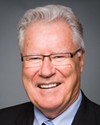Thank you, Mr. Chairman.
I'm honoured to have been asked to talk to you today. My understanding is that the committee, as part of its work, is seeking a better understanding of the key issues and challenges related to first nations land and environmental management on reserve.
I was recently involved in coordinating research, undertaking literature reviews, and preparing discussion papers in this area to help animate the discussions and support the work of the Assembly of First Nations/Aboriginal Affairs and Northern Development joint working group on additions to reserve.
It is this work I'll be drawing from in my remarks, principally from discussion papers that I understand came to the attention of the committee on additions to reserve and the environmental regulatory gap.
Having said that, I am here as an individual, not to represent the working group or either of the parties.
It is useful to position where first nations are on the continuum of land management activities relating to reserve, remembering that my data was compiled in 2010.
First, two-thirds of all first nations had no involvement in this continuum and were not receiving any land management funding.
Second, less than 10% were exercising any form of delegated or self-government authority over their lands—although FNLMA has increased this recently—and the lands advisory board, which I think has already spoken to the committee, feels it could up this to 20% or 25% over time, given resources for FNLMA. Even if this could happen tomorrow, it would still leave 75% to 80% of first nations operating under the Indian Act over the longer term.
I understand the committee is also interested in identifying what alternative land management options might be considered for those who do not have access to or are awaiting to access FNLMA, and that is the main focus of my remarks.
Looking at the research, we first find that numerous researchers are pointing to the need for improvement in individual property rights on reserve over those afforded first nations by the federal government under the Indian Act, while protecting the communal nature of reserve lands. Unfortunately, the two instruments under the Indian Act most often cited as effective in this regard have proven to be bureaucratically very cumbersome, suffer from major land-use planning and regulatory gaps, and are not instruments that many first nations are comfortable with. These are certificates of possession, or CPs, which are issued by the Minister of AAND on the request of the band and used to grant title to individual members; and designating lands by way of referendum for leasing by the department.
Looking at each of these in turn, certificates of possession are an anathema to many. First, as noted in a companion study by Professor Bradford Morse and Yvonne Boyer, CPs are the successors to the location tickets used in the 1800s. They were part of the singularly unsuccessful historical system of enfranchisement, whereby Indians were to be educated in church-run schools, give up their identity, and be provided with individual land allotments that would be taken away from their reserves. They were later used under the Indian Act by Indian agents, often under questionable circumstances.
Secondly, there is no effective legislative mechanism for either the first nation or the federal government to regulate CP land use once the CPs are granted. This creates a regulatory vacuum that gives rise to many of the questionable land-use activities currently found on reserve. I would note that the Canadian Human Rights Tribunal in the Beattie decision appears to rely on just such regulation by the first nation.
Thirdly, AANDC's estate operations, as they relate to intestate CP holders, appear to be dysfunctional, giving rise to many unresolved CP estate issues. At last count, the department was running a backlog of over 500 section 50 sales on behalf of non-member beneficiaries. As an example, Akwesasne alone apparently has over 250 CPs with unsettled divided interests among member beneficiaries. The issue is compounded by the fact that 15,000 CPs have been registered without any surveys.
The net result of all of this is that new CPs, which must be requested by the first nation, are being issued at a rate that is satisfying less than 5% of new household formation on reserve.
As for designations, despite huge efforts by the Indian Taxation Advisory Board—now the First Nations Tax Commission, which you have also heard from—which championed the Kamloops amendment to the Indian Act in 1988 establishing the legal distinction between absolute surrenders and conditional designations, many first nations do not trust or understand the distinction, especially given the sorry history of surrenders in Canada.
Second, the designation process suffers from using the highly onerous Indian Act surrender provisions, in terms of voting process, ratification thresholds, and the bureaucratic management process. The result is that AANDC presentations to first nations state, “The designation process will require a minimum of 2 years to complete and more often...at least 3...and drafting a new lease can take up to two more years”, for a total of five years—hardly the speed of business. As a result, many first nations find designation votes highly divisive, with the vast majority of votes having to go to a second vote with a lower threshold before they are successful. You could then ask, why have the first vote?
This leads us to our second major research finding, that as the 31 more successful first nations who participated in the recent reserve land and first nations development study noted, and I quote:
Today INAC is even more the problem than the Indian Act, due to underfunding of its own operations and those of First Nations...and lack of competence and instability in staffing, with the result that more successful First Nations currently have more success...working outside the Indian Act than inside it.
Not surprisingly, then, in a comparable study conducted by the aboriginal affairs group, we found that a large proportion of reserve land-use activities are not registered in the Indian lands registry at all, and involve no federal approvals, as they are either what are loosely termed “buckshee leases” by bands or CP holders, or “custom” allotments by bands to members. Specifically, around 80% of all individual/family allotments are done outside the Indian Act; 50% of total band leasing is unregistered; and 66% of all short-term usage of reserve lands, like for gravel pits, garbage dumps, etc., is not federally regulated.
Our third major research finding, which follows from this, which was confirmed by both AANDC and Environment Canada in their response to the fall 2009 report of the Auditor General, is that there is a significant environmental regulatory gap on reserve and that legislation is required.
On environmental assessment, despite first nations requests, and apparently due to cost considerations, since 1992 no regulations under section 59 of CEAA have ever been passed to allow first nations to operate under CEAA. Equivalently, on environmental protection, the government designed part 9 of CEPA in 1999 to help close the environmental protection gap on federal land, which CEPA defines as including reserves, but no regulations specific to reserves have ever been passed.
While first nations have some local bylaw, business regulation, and land-use planning authority under the Indian Act, which they could use for environmental protection and land and resource management purposes, these provisions are antiquated, unfunded, and have penalty and enforcement provisions that are totally inadequate. Unfortunately, these same provisions apply to federal authorities, and as the Auditor General found, the result is that AANDC does not enforce any of its Indian Act resource or environmental management regulations.
Up to this point, the federal approach to environmental management on reserve has been incremental: to work on specific areas of legislative and regulatory development under federal administration, as they each became critical and reached a tipping point in terms of health and safety and/or growing federal legal liabilities. However, as was reported to Environment Canada in 2007:
While progress is being made...it is highly unlikely that the expected outcome of holding operations on Aboriginal lands to the same environmental protection and prevention standards as comparable operations on adjacent non-Aboriginal lands—will be met.
With oil and gas now separate under the Indian Oil and Gas Act, major projects separate under the First Nations Commercial and Industrial Development Act, and water potentially separate under the Safe Drinking Water Act, it now appears that the “residual environmental gap” identified by the Auditor General in 2009 effectively encompasses all local works other than water, all residential and small and medium business activities, and all non-oil and gas resource activities on reserves in Canada.
Here it has often been pointed out that it would be much more effective to have these more local projects regulated by first nations themselves through improvement in band law-making and enforcement powers, especially as they relate to land-use planning and zoning, similar to other communities in Canada.
The fourth major research finding relates to additions to reserve. Here the joint working group referenced earlier successfully completed its initial mandate with its recommendations to AANDC in 2010 to create a new ATR policy category to give priority to ATRs resulting from decisions from the claims tribunal. If implemented, this would result in three positive ATR categories: legal obligations, for example, as they arise from TLE and specific claim agreements; tribunal decisions; and normal community growth.
Given this and the recent progress AANDC has made to improve ATR operations in order to meet its legal obligations in the Prairies, the key ATR issues that stood out from the research related to more general ATR policy considerations and to legislative issues.
On policy, there is a range of overlapping issues flowing from the last ATR policy review with the AFN in 2001, which were either left undone or have been too narrowly interpreted operationally, including the narrow definition of service area being used in some regions, the inappropriate exclusion of economic development from normal community growth needs, and the failure to put in place an adequate community land-use planning regime to support the policy on community growth. Collectively, these impact heavily on community growth additions, important in those regions largely in eastern Canada with small reserves and little claims activity.
On legislation, from the experience in Alberta, Saskatchewan, and Manitoba with legal obligations under the claims implementation legislation, there is a range of possible legislative initiatives that would improve the ATR process for all categories, including a national version of the current prairie claims implementation legislation, inclusion of all categories of ATR rather than just claim settlements, the ability to have ministerial rather than Governor in Council approval of Indian Act section 35 easements, an alternative and more reasonable ratification procedure for pre-reserve designations to accommodate third-party interests, and the potential for land-use planning votes, adequate zoning bylaw authorities, and the recognition of first nations instruments to replace designations completely and facilitate the whole process before and after reserve creation.
The final finding from the research was that the current situation with respect to land and environmental management on reserve, as described previously, appears to serve no one's interests. Consider the following.
First, the current situation represents a major barrier to sustainable economic development on reserves, which house the most significant underemployed group of people in Canada. This situation results in a major opportunity cost to the Canadian economy. The Centre for the Study of Living Standards estimated this cost at $36.5 billion in annual lost economic output, $14.2 billion in annual expenditures, and $3.5 billion in annual lost tax revenues to Canada as a whole by 2026.
Second, just looking at the growing federal litigation liability, it appears that it could well be less expensive in terms of direct cost to the federal treasury to close the gap than to maintain it. According to a recent study done for the National Aboriginal Land Managers Association, the total federal land-based contingent liability is some $5.74 billion. These liabilities are growing at an annual rate that is greater than the entire lands management budget of INAC.
Third, as a result of TLE and specific claim settlements, the reserve land base is growing dramatically, as is the on-reserve population. When you couple this with the facts that specific claim settlements are not fully costed and that the reserve land base is not considered a cost driver for budget purposes by Treasury Board and AANDC, the AANDC lands A-base operational budget has effectively been in decline for decades, both in real terms and in relation to the reserve land base. With neither first nations nor AANDC and Environment Canada having the necessary legislative authority or resources to manage reserves to a standard anywhere near comparable to that for other communities in Canada, as they noted to Parliament in 2009, the problem can only get worse.
I would therefore draw four points to the committee's attention.
First, there clearly is a role for specific improvements in both ATR policy and legislation of the type I understand is now under discussion in the AFN/AANDC working group. This would benefit both FNLMA and non-FNLMA bands.
Second, either as part of this or separately, there is also a central role in all the issues cited for both an alternative and/or more reasonable ratification procedure for both pre-reserve and post-reserve designations and an initiative to provide first nations with adequate land-use planning and bylaw authorities.
Third, as was reported to Environment Canada in 2007, the regulatory gap has been documented and studied for over a decade, and there is urgent need for action. Given the failings of the incremental approach, it now appears time to fill the environmental gap as a comprehensive package.
Fourth, the estates issue is a tragedy and needs urgent attention.
In conclusion, I would note that these findings appear consistent with the results of the recently published first nations land and economic development study, in which 31 of the more successful first nations were interviewed.
The first three recommendations to government from these first nations were as follows: first, do what you have to do well—speed up additions to reserves, lower the threshold for designation votes; second, build a tool kit so first nations can manage the rest—land-use planning, zoning, bylaw enforcement, etc.; third, clean up the mess you have created—speed up claim settlements, fix the reserve parcel fabric, clear up the estates backlog.
Thank you.












